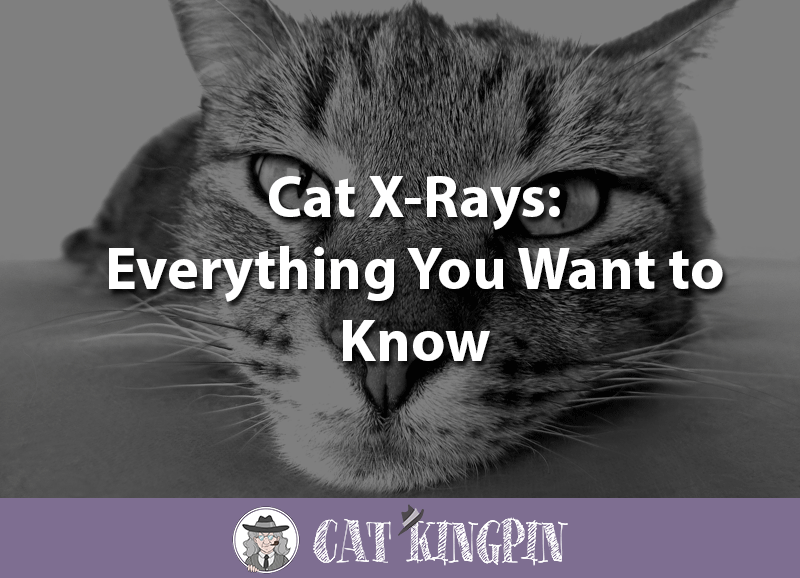Cat X-Rays – Everything You Want to Know
Have you recently been to the vet and learned your cat is going to need an x-ray? Has your cat injured themselves and you want to get him or her to the vet, but you’re worried about how much the x-ray will cost? Or maybe your kitty just doesn’t like going to the vet and you’re concerned with how well they’ll tolerate getting x-rayed?
Well, you can relax.
While your cat probably won’t particularly enjoy going to the vet, x-rays are a routine procedure that are done in hundreds of veterinary clinics every day, and it won’t break the bank!
In this article, we’ll cover the following;
- Why Would a Cat Need an X-Ray?
- How Does a Cat Get an X-Ray?
- How Long Does a Cat X-Ray Take?
- What Does a Cat X-Ray Show?
- How Much Do Cat X-Rays Cost?
- How Much Do Kitten X-Rays Cost?
- Are Cat X-Rays Dangerous?
- What Should I Do if My Cat Needs an X-Ray?
Why Would a Cat Need an X-Ray?
There are many reasons a cat might need an x-ray, which are referred to in the medical field as radiographs. Three of the most common types of x-ray procedures utilized are Chest X-Rays, Dental X-Rays, and Abdominal X-Rays.
Chest X-Ray
A chest X-ray can help to diagnose respiratory conditions involving the lungs, including:
- Asthma
- Bronchitis
- Viral or Bacterial Infections such as Pneumonia and Feline Leukemia
- Tumors
Chest x-rays can also help identify broken ribs or heart disease.
Dental X-Ray
Dental x-rays are used to help diagnose conditions of the teeth, gums and other parts of the feline oral cavity. These x-rays help to identify problems such as cavities, periodontal disease, and oral masses.
The following video gives you a good overview of the dental x-ray procedure:
Abdominal X-Ray
Abdominal x-rays help to examine the organs and tissues of the abdominal region, such as the kidneys, bladder, and uterus in female cats. Abdominal x-rays can help find bladder and kidney stones, urethral obstructions and feline miscarriages.
X-Rays are also taken after surgeries to see if a procedure, such as setting a broken bone, was successful.
If your cat has been wandering and comes back limping or acting unusual, you may need an x-ray to find out if something happened to your furry friend while he or she was out and about.
How Does a Cat Get an X-Ray?
Getting a cat an x-ray is a relatively routine procedure at most veterinary clinics. What is most important is that the cat must remain still to get a clear x-ray image.
If the cat is cooperative, there is usually no need for sedation. In most cases, the veterinary technician simply holds the cat in the required position. If the cat is really uncooperative or just will not sit still, sedation may be required.
In the video below, you can see a typical x-ray procedure from start to finish:
How Long Does a Cat X-Ray Take?
The actual taking of the x-ray image lasts only a couple minutes. However, the entire procedure can take considerably longer due to a number of factors. These include how many different positions must be imaged, whether an image needs to be evaluated to determine if additional images must be taken, and the time it takes for the cat to be fully sedated, if necessary, and then wake back up.
Most often you can expect the entire x-ray procedure to take around an hour, but it can be considerably shorter or longer.
What Does a Cat X-Ray Show?
Generally, x-rays take images where denser materials, such as bone and metal appear white, organs and tissues appear gray, and air appears black. X-Ray images can show many things going on inside of a cat that are not visible to the naked eye.
A web page from Long Beach Animal Hospital gives excellent examples of feline radiographs so you can see for yourself what the vets are seeing!
How Much Do Cat X-Rays Cost?
Depending on the reason for the procedure, there can be a range of costs for getting an x-ray for your cat. Most commonly, you can expect to pay between $100 and $250 for x-rays of your cat’s chest or abdomen. Dental x-rays usually range from $75 to $150.
There could also be additional costs for other procedures associated with getting your cat an x-ray. For example, if your cat must be sedated, this can add another $55 to the cost of the x-ray procedure. Additionally, if the veterinarian identifies a particular injury or illness from the x-ray, your cat could require additional testing such as bloodwork, or specific treatments that may come with a wide range of costs.
How Much Do Kitten X-Rays Cost?
The vast majority of veterinarians do not distinguish between cats and kittens when it comes to the cost of X-rays. You can expect to pay about the same for getting your kitten an x-ray as you would pay for an adult cat.
Again, there can be a wide variety of indirect costs, depending on the kitten’s medical condition.
Are Cat X-Rays Dangerous?
X-rays are a type of electromagnetic radiation with enough energy to ionize atoms and disrupt molecular bonds. X-rays are known to damage living tissue, and the extent of that damage depends primarily of how much x-ray radiation your cat is exposed to. Exposure to x-rays does increase the risk of later developing cancer, but does not affect the kitten’s eye color or fur.
In people, a typical chest x-ray is equivalent to about 10 days of natural environmental background radiation, and a dental x-ray exposes the patient to the equivalent of one additional day of environmental background radiation. While the added cancer risk from x-rays is not insignificant, the substantial benefit from being able to diagnose a patient’s medical condition must be weighed against the small increase in cancer risk associated with exposure to x-ray radiation.
While x-rays are often medically necessary, it is best to limit the number of x-rays and amount of x-ray radiation a patient is exposed to. Often the technician taking the x-ray will use lead shielding to reduce a patient’s x-ray exposure to just the area needing to be examined.
X-Rays are particularly dangerous to unborn kittens. Damage to the tissues of developing fetuses and embryo can cause birth defects or even miscarriage. If your cat needs an x-ray, it is extremely important that you tell your veterinarian if you suspect your kitty is pregnant.
What Should I Do if My Cat Needs an X-Ray?
The main thing to consider if your cat has an upcoming x-ray scheduled is that they may need to be sedated in order to do the procedure. Sedated animals are at risk for vomiting and aspirating any food or liquids they may have consumed prior to the sedation.
Therefore, the general guideline is to fast your cat for the 12 hours prior to the procedure and withhold water after 6 am for a procedure later that morning. Your veterinarian will likely have specific instructions regarding the withholding of food and water for your pet and it is important you follow these precisely.
Although uncommon, certain medications can have an effect on X-Ray results. It is important you consult with your veterinarian at least a day before the x-ray to determine whether any medications your cat is taking should be given or withheld before the procedure.
Finally, the day of the procedure is likely to be a stressful one for your cat. It is important that you keep your cat calm prior to going to the vet and make sure to give him or her their space upon returning to your home. This is especially true if your kitty had to be sedated and still feels a little groggy.
X-Rays are an important medical tool that allows a vet to see things inside your cat that they would otherwise not see. While there is a small, long-term, increased risk of cancer, x-rays are often medically necessary to diagnose a number of conditions. If you have concerns, make sure you talk to your vet and they will be happy to explain both the benefits and risks associated with getting your cat an x-ray.
If you have any questions or would like to share a story about your cat and X-Rays, please tell us in the comments below, we’d love to hear from you.







